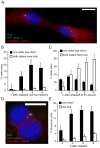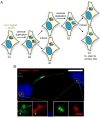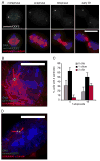Centriole age underlies asynchronous primary cilium growth in mammalian cells
- PMID: 19682908
- PMCID: PMC3312602
- DOI: 10.1016/j.cub.2009.07.034
Centriole age underlies asynchronous primary cilium growth in mammalian cells
Abstract
Primary cilia are microtubule-based sensory organelles that play important roles in development and disease . They are required for Sonic hedgehog (Shh) and platelet-derived growth factor (PDGF) signaling. Primary cilia grow from the older of the two centrioles of the centrosome, referred to as the mother centriole. In cycling cells, the cilium typically grows in G1 and is lost before mitosis, but the regulation of its growth is poorly understood. Centriole duplication at G1/S results in two centrosomes, one with an older mother centriole and one with a new mother centriole, that are segregated in mitosis. Here we report that primary cilia grow asynchronously in sister cells resulting from a mitotic division and that the sister cell receiving the older mother centriole usually grows a primary cilium first. We also show that the signaling proteins inversin and PDGFRalpha localize asynchronously to sister cell primary cilia and that sister cells respond asymmetrically to Shh. These results suggest that the segregation of differently aged mother centrioles, an asymmetry inherent to every animal cell division, can influence the ability of sister cells to respond to environmental signals, potentially altering the behavior or fate of one or both sister cells.
Conflict of interest statement
The authors declare that they have no conflicts of interest.
Figures




Similar articles
-
The centrosome cycle: Centriole biogenesis, duplication and inherent asymmetries.Nat Cell Biol. 2011 Oct 3;13(10):1154-60. doi: 10.1038/ncb2345. Nat Cell Biol. 2011. PMID: 21968988 Free PMC article. Review.
-
Mechanism and Regulation of Centriole and Cilium Biogenesis.Annu Rev Biochem. 2019 Jun 20;88:691-724. doi: 10.1146/annurev-biochem-013118-111153. Epub 2019 Jan 11. Annu Rev Biochem. 2019. PMID: 30601682 Free PMC article. Review.
-
The Centrosome and the Primary Cilium: The Yin and Yang of a Hybrid Organelle.Cells. 2019 Jul 10;8(7):701. doi: 10.3390/cells8070701. Cells. 2019. PMID: 31295970 Free PMC article. Review.
-
Once and only once: mechanisms of centriole duplication and their deregulation in disease.Nat Rev Mol Cell Biol. 2018 May;19(5):297-312. doi: 10.1038/nrm.2017.127. Epub 2018 Jan 24. Nat Rev Mol Cell Biol. 2018. PMID: 29363672 Free PMC article. Review.
-
Centriole amplification by mother and daughter centrioles differs in multiciliated cells.Nature. 2014 Dec 4;516(7529):104-7. doi: 10.1038/nature13770. Epub 2014 Oct 12. Nature. 2014. PMID: 25307055
Cited by
-
Emerging mechanisms of asymmetric stem cell division.J Cell Biol. 2018 Nov 5;217(11):3785-3795. doi: 10.1083/jcb.201807037. Epub 2018 Sep 19. J Cell Biol. 2018. PMID: 30232100 Free PMC article. Review.
-
Cilia and coordination of signaling networks during heart development.Organogenesis. 2014 Jan 1;10(1):108-25. doi: 10.4161/org.27483. Epub 2013 Dec 17. Organogenesis. 2014. PMID: 24345806 Free PMC article. Review.
-
Genetic causes of microcephaly and lessons for neuronal development.Wiley Interdiscip Rev Dev Biol. 2013 Jul;2(4):461-78. doi: 10.1002/wdev.89. Epub 2012 Oct 4. Wiley Interdiscip Rev Dev Biol. 2013. PMID: 24014418 Free PMC article. Review.
-
Katanin p80 regulates human cortical development by limiting centriole and cilia number.Neuron. 2014 Dec 17;84(6):1240-57. doi: 10.1016/j.neuron.2014.12.017. Neuron. 2014. PMID: 25521379 Free PMC article.
-
Primary cilia as dynamic and diverse signalling hubs in development and disease.Nat Rev Genet. 2023 Jul;24(7):421-441. doi: 10.1038/s41576-023-00587-9. Epub 2023 Apr 18. Nat Rev Genet. 2023. PMID: 37072495 Free PMC article. Review.
References
-
- Fliegauf M, Benzing T, Omran H. When cilia go bad: cilia defects and ciliopathies. Nat Rev Mol Cell Biol. 2007;8:880–893. - PubMed
-
- Corbit KC, Aanstad P, Singla V, Norman AR, Stainier DY, Reiter JF. Vertebrate Smoothened functions at the primary cilium. Nature. 2005;437:1018–1021. - PubMed
-
- Rohatgi R, Milenkovic L, Scott MP. Patched1 regulates hedgehog signaling at the primary cilium. Science. 2007;317:372–376. - PubMed
-
- Schneider L, Clement CA, Teilmann SC, Pazour GJ, Hoffmann EK, Satir P, Christensen ST. PDGFRalphaalpha signaling is regulated through the primary cilium in fibroblasts. Curr Biol. 2005;15:1861–1866. - PubMed
Publication types
MeSH terms
Grants and funding
LinkOut - more resources
Full Text Sources
Other Literature Sources
Molecular Biology Databases

